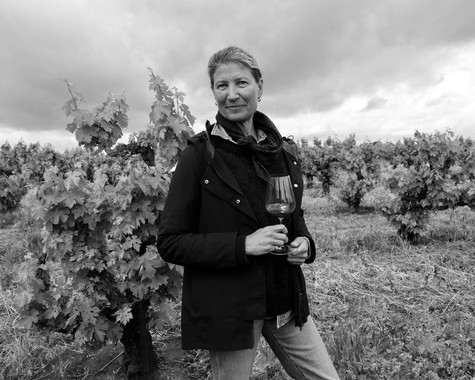Letters from Lodi
An insightful and objective look at viticulture and winemaking from the Lodi
Appellation and the growers and vintners behind these crafts. Told from the
perspective of multi-award winning wine journalist, Randy Caparoso.
Christmas 2023! Lodi wines suitable for the collectors in your life
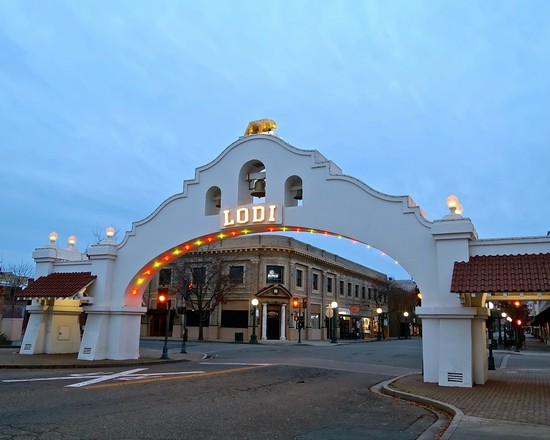
Lodi wine country during December.
Christmas shopping for discriminating wine lovers is next to impossible. They may know what they like, but what that is is anyone's guess. Taste in fine wine, as in all matters of taste, is a highly personal choice.
Hence, the following list, which is not a "best of." It is a list of a dozen Lodi-grown wines released in 2023 that would appeal to collectors because there is something about each that is a little out of the ordinary. And there's nothing connoisseurs like better than things that are out of the ordinary.
Each of these wines, of course, are also very good. They would appeal to anyone who appreciates wines of exceptional quality.

Best of all, each wine is very "Lodi"—distinctive to the appellation on a sensory level, on an intellectual level, or both.
As such, these are all ideal bottlings for the connoisseurs in your life, if you happen to be shopping for them. Without further adieu...
2021 Markus Wine Company, Lodi Sparkling Bacchus ($36)
This is a tiny lot Champagne style wine made 100% from a grape called Bacchus. Absolutely no one else on the West Coast that we know of grows this grape. At least not commercially. It's grown in Lodi's Mokelumne Glen Vineyards because this tiny estate was, in fact, founded by a fanatical collector of grapes (the late Bob Koth). He planted over 50 varieties of wine grapes of German or Austrian origin.
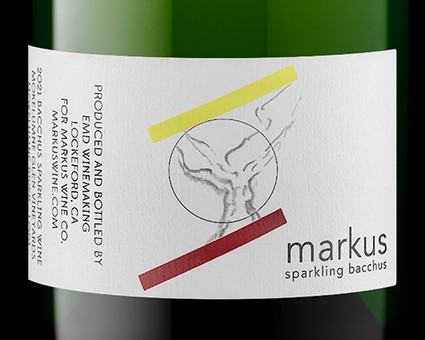
The Bacchus grape was devised in 1933 by a German grape scientist who crossed a crossing (Silvaner x Riesling) with Müller-Thurgau; the latter variety, an 1882 crossing of Riesling x Madeleine Royale. Many connoisseurs pooh-pooh wines made from Bacchus because they can be narrowly defined and unpredictable at that. Growers hate it because it is a stubborn ripener. The grape, however, seems to have found a comfort zone in Lodi—still a slow ripener, but producing light and lively dry whites possessing fragrant herbal and mineral nuances.
Markus Wine Company's Sparkling Bacchus is light as a feather and is finished bone dry. Its fresh, perky acidity natural to the grape sings with intricate mineral, oil of lemon peel, wet stone, nectarine and pear-like scents, underlined by the brioche-like yeasty nuances typical of wines made in the classic Champagne style. I consider myself a connoisseur, and this wine absolutely floats my boat.
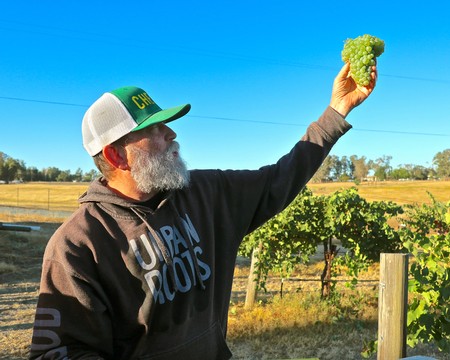
Craig Haarmeyer harvesting 2022 Chenin blanc in Palmero Family Vineyard.
2022 Haarmeyer Wine Cellars, Cresci Borden Ranch-Lodi Chenin Blanc ($30)
A good Chenin Blanc is always cause for celebration, even if wines made from this grape are not exactly predictable. They can be opulently fruity or lean and mean as water squeezed from a stone, and anywhere in between.
Owner/winemaker Craig Haarmeyer prefers to pick his Lodi-grown Chenin blanc—sourced from a vineyard originally planted by Gerald Cresci in 1983 (now owned by the Palmero family)—early enough so that alcohol levels finish below 12%. The 100% dry sensory qualities are driven by citrusy grape acidity which results in a perceptive minerality, with the honeyed, floral varietal fragrances woven into the wine like a fine gossamer fabric.
Who knew that a white wine from Lodi could be so deep and minerally? It most certainly can, in the hands of conscientious vintner like Haarmeyer.
2022 Acquiesce Winery, Mokelumne River-Lodi Jolie ($34)
Acquiesce Winery & Vineyards now produces a full range of white wine blends from the six varieties of Southern French white wine grapes in which this grower estate specialize. Every one of them is great! This year, the "Jolie" is the stand-out; consisting of Grenache blanc (60%) and Viognier (40%). When you sniff and sip this wine, you can't help think "essence of Provence"—the lavender-like note of the Grenache blanc and the violet-like fragrance of the Viognier intertwine with citrus and briny minerals like a climbing flowering bush on a fence. The finish is graceful and fresh as a stem. Not just very "Lodi," world class in finesse and sheer quality!
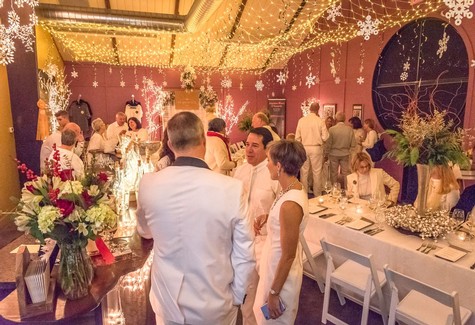
"White Christmas" party at Acquiesce Winery.
2022 Perlegos Family Wine Co., Thera Block Clements Hills-Lodi Assyrtiko ($28)
For many years it was thought that Lodi was a perfect wine region for grapes of Greek origin. At long last, this first-ever commercial bottling of a Lodi-grown Assyrtiko—grown and produced by Perlegos Family Wine Co., second generation vintners of Greek lineage—is proving exactly that. It has everything long associated with this white wine grape: billowingly honeyed aromas, a briny scent, very full body and lots and lots of zesty, zingy, edgy acidity.
It is, of course, very "Lodi." There is an exotic kaffir lime-like citrusiness to the scent, and the acid-driven minerality verges on an oceanic brininess; although the latter sensory note clearly intrinsic to the grape, since the Clements Hills appellation where this wine is grown is a good 95 miles from the Pacific Ocean. On the palate, the sense of fullness is creamy textured; nonetheless punctuated by a pointed, slightly phenolic, citrus skin tartness. Truly adventurous white.
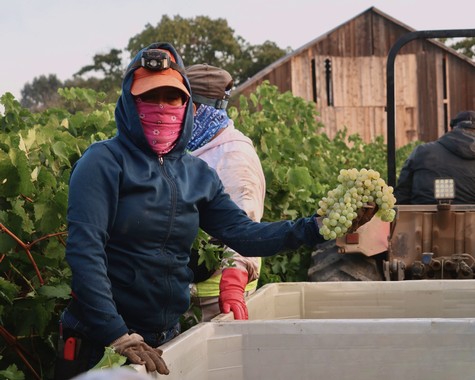
Assyrtiko harvest in Perlegos Family Vineyards.
2021 Lucid L.02 "Urban Flora," Mokelumne River-Lodi Mission Rosé ($28)
In this day and age of increasingly blurred lines of self-identity, it is hard to say whether this wine is truly a rosé, or if it's a pale-colored red wine that just thinks it's a rosé. All the same, this wine is best enjoyed chilled, like any bone dry rosé—there is no real red wine tannin (the bitter components of red wines derived from skins and seeds) to speak of. But its bright and vivid orangy-red cast almost gives the game away, and the nose is deep and, well, red wine-ish: intensely fragrant with cherry/raspberry fruit, a touch of "Jolly Rancher" perfume and a slightly herby/kitchen spice funkiness, coming together on a crisp, light (12.9% alcohol) palate feel.
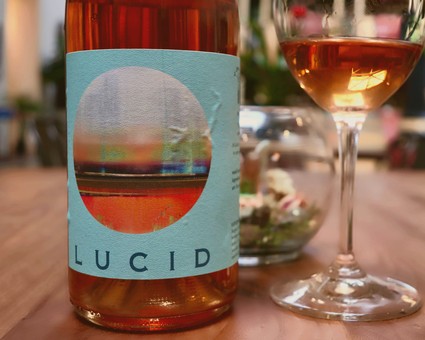
Lucid's "Urban Flora," a rosé exquisitely crafted from the much maligned Mission grape.
When we spoke to him this past spring, Lucid winemaker/owner Kevin Luther fully admitted going for an identity crisis; saying, "the Urban Flora definitely treads a fine line between red and rosé." To achieve this, Luther fermented with the skins for several days, like you would any red wine, but then pressed off at about 3°, 5° Brix (i.e., sugar reading)—the latter maneuver, minimizing extraction of bitter-tasting tannin derived from skins.
Adds Luther, "Aging is in a combinational of steel and neutral French oak, although I did use a little bit of cherry wood in the barrels." The wood of cherry trees do not make good wine barrels—it produces staves that are too porous to hold liquids—but the use of cherry as a wood amendment (inserted into oak barrels during the aging process) does add an intriguing touch to the wine.
As it were, making any kind of wine from the Mission grape—a variety first brought to California by Franciscan missionaries in the late 1700s, and held in utter disdain by California vintners since statehood (in 1850)—is something of a gamble. Here is one that pays off in spades!
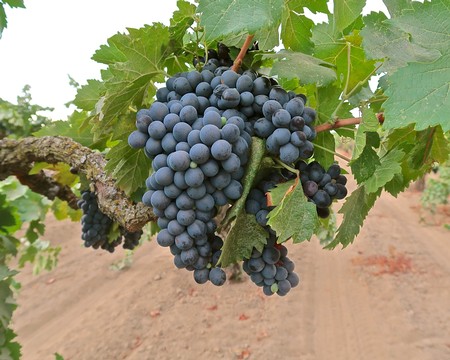
Cinsaut clusters in Lodi's historic Bechthold Vineyard on harvest morning.
2021 Lorenza Wine, Bechthold Vineyard Mokelumne River-Lodi Cinsaut ($36)
For years and years, California red wines have been rated by how full bodied and intense in fruit character they are. So how can a wine such as the Lorenza Wine Cinsaut—so light that that many wine lovers would question its credentials as a red wine—be considered so important? Simple reason: because many consumers are now way beyond the old idea of "the-bigger-the-better." They now appreciate "the-finer-the-better," and the Lorenza Bechthold Vineyard Cinsaut—sourced from Lodi's oldest and most historic vineyard, planted in 1886—is as fine as a wine can be.
Lorenza's Melinda Kearney among ancient vine Cinsaut in Lodi's venerated Bechthold Vineyard.
The lightness has to do with the fact that, the grapes going into this wine was originally picked produce a rosé, not a red wine, from their 2021 harvest. This means the grapes were picked at a lower Brix and pH (translating into higher natural acidity). The result is a red wine weighting in at a scant 11% alcohol (most Bechthold Vineyard reds hover closer to 13% or 14%). Yet it has all the intensity of red Cinsaut—soaring raspberry/cherry perfume and deep, pervasive kitchen spice (cardamom, mace, clove, a twist of peppercorn) in the nose.
The wine's lightness and accentuated acidity, in fact, takes the conception of Cinsaut into still another dimension on the palate in the way of subtle earthy/mineral nuances mingling with the bright, zingy, purely defined (i.e., unperturbed by any extraneous oak qualities) character of the grape. As such, what a joy!
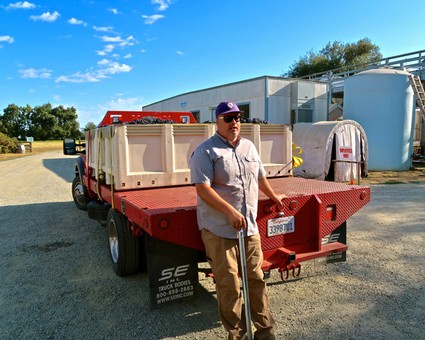
Sandlands' Tegan Passalacqua packing up his just-picked Carignan from the historic Spenker Ranch block, planted in 1900.
2021 Sandlands, Lodi Carignan ($28)
Every revival of Carignan—another long overlooked historic grape—is always cause for celebration. Only a few hundred acres of Carignan blocks, all well over 50 years old, remain in Lodi; and once, by dint of its Mediterranean origin, this was the most widely planted grape in all of California.
Sandlands' bottling is sourced entirely from Spenker Ranch, planted on its own roots in 1900. Everything about this wine tells you why California vintners were high on this grape for so long: Super-saturated in purplish ruby color and and a nose redolent of black cherry, flower petals, violet and lavender underscored by faint, loamy earth tones.
The sumptuous fruit flavors are driven by high energy natural acidity, lifting the flavors above rounded tannin of moderate density. Oak is a near-zero factor; all the better to show off the grape and Lodi's signature earthy terroir in resonating fashion. A wine that positively screams "Lodi!"
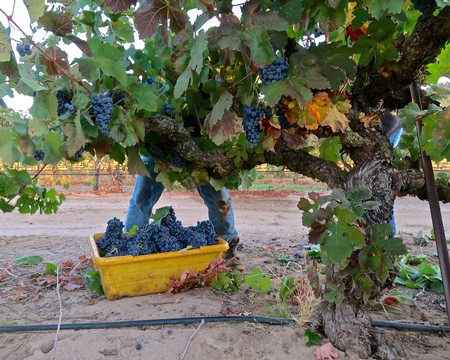
Carignan harvest in Spenker Ranch, a historic Mokelumne River-Lodi vineyard planted in 1900.
2021 Harney Lane Winery, Henry Ranch Mokelumne River-Lodi Petite Sirah ($34)
This rendering of this popular grape—the sixth most widely planted variety in the Lodi AVA—represents a new, improved iteration of this varietal as a category. Whereas the vast majority of California Petite Sirahs are excessively high in alcohol, ultra-ripe in fruit and pungently smoky/oaky, Harney Lane's home vineyard bottling comes across as refined, nuanced and delineated in its spiced blueberry varietal character, rather than lumbering or bludgeoning. Yet the overall feel is full bodied—certainly full enough to please any Petite Sirah lover—while the plush, layered qualities are artful in their sense of balance. A connoisseur's style of the varietal.
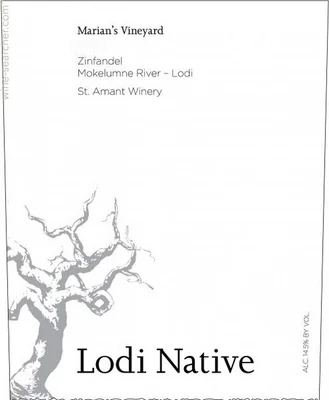
2021 Lodi Native, Marian's Vineyard Zinfandel ($35)
The Lodi Native group started off in 2012 with six vintners producing single vineyard designated Zinfandels, all from heritage growths, following strictly "natural" protocols; that is, native yeast fermentation, absolutely no additions such as enzymes, acidification or water to lower alcohol levels, and use of strictly "neutral" (or older) oak barrels to allow the characteristics of each vineyard to shine through.
Virtually all the media, trade and consumers who tasted the first few vintages of Lodi Natives said the same thing: "Why, these wines don't taste like Zinfandel at all!" Which was understandable. Lodi Natives were never meant to taste like "Zinfandel," they were meant to taste like the vineyards they were made from. They were meant to taste like "Lodi."
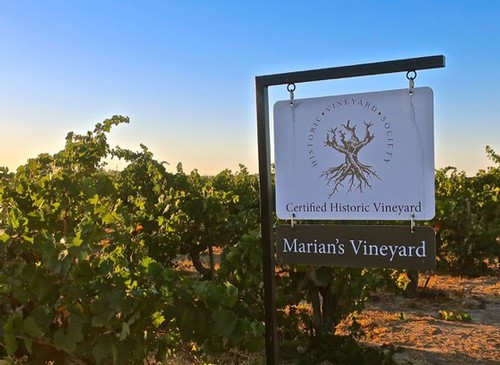
Historic Vineyard Society sign in Lodi's Marian's Vineyard—own-rooted Zinfandel planted in 1901.
The 2021 Marian's Vineyard Zinfandel, is the tenth vintage of Lodi Native crafted by St. Amant Winery. It will also be their last (only one other original Lodi Native producer, Maley Bros., plans to continue bottling wines under this label). Typical of this venerated vineyard, originally planted in 1901, this bottling is luxurious—make that soaring—in its floral berry perfume, vibrant in natural acidity, full bodied yet svelte, layered and exuberant in its purity of fruit.
But does it taste like "Zinfandel?" Not if you expect something big, jammy or sweetly oaked, like the vast majority of California Zinfandels. What it tastes like is... Marian's Vineyard.
If you're worried about this being the last of the Lodi Natives made from this vineyard, I wouldn't. St. Amant owner/winemaker Stuart Spencer intends to craft future bottlings of Marian's Zinfandel under the regular St. Amant label in the same puristic fashion. The Lodi Native movement will live on, at least philosophically.
2020 Michael David Winery, Reserve Lodi Zinfandel ($44)
This Zinfandel is crafted in the opposite style of a Lodi Native Zinfandel, yet is very much "Lodi" in its varietal profile: sumptuous in red berry/cherry fruit, pungently spiced (i.e., black pepper, white pepper, cinnamon/clove), rounded in tannin and mildly earthy in a loamy sense—all Lodi sensory signatures.
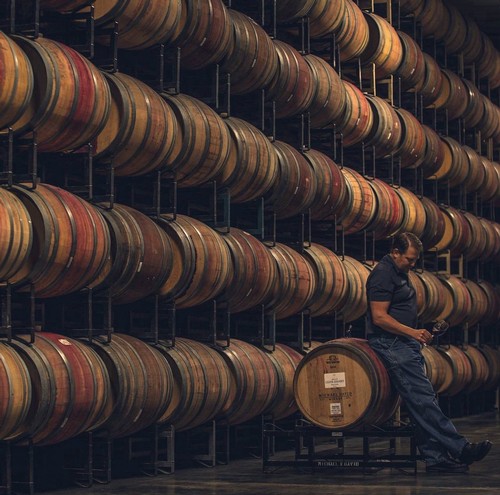
Ultra-premium French and American oak barrels in Michael David Winery's cellar.
While a partial amount of new American and French oak barrels is also very much a part of the Michael David Reserve (which also makes it the opposite of a Lodi Native style), all these barrels do is add luxurious, almost espresso-like nuances that simply enhance and lift the natural spice and earthy tones of the Lodi-grown fruit, adding an almost truffle-like allure. A smidgen of Petite Sirah (one more factor contrary to Lodi Native protocols) add a deeper, blackberry-like fruit quality to the varietal berryishness.
What this is is a great, great Zinfandel, comparable in breadth and complexity to any in California, while retaining its essence as a Lodi-grown wine. All told, plenty to celebrate!
2021 Michael David Winery, Reserve Lodi Syrah ($55)
Syrah is one of the classic "Rhône" grapes, long associated with France's Mediterranean climate. For that reason, it has been long been thought that Lodi should be a natural home for Syrah. Only thing, the region has never been known for Syrah like, say, its Zinfandel (the latter, also originating in the Mediterranean Basin).
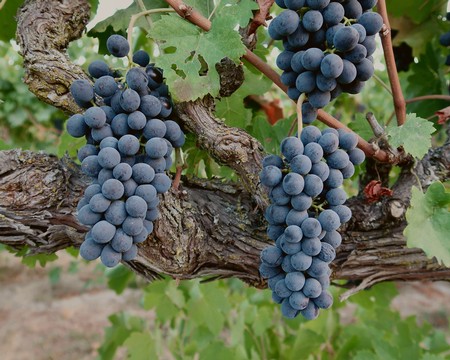
Lodi appellation Syrah.
Until now. Since Phillips family was the first to plant Syrah in the Lodi appellation nearly fifty years ago, it makes sense that the family's Michael David Winery should be the first to produce a Syrah that could very well be described as world class. To produce this 2021 bottling, six barrels worth of crème de la crème juice were aged for 15 months in ultra-premium French oak (14% new). Nothing was spared.
The result: an essence of black cherry, twists of sweet black pepper and the faintest whiff of leather wrapped around velvety, plummy/blueberry sensations, tinged with scents suggesting espresso and cocoa nibs. On the palate, the overall feel is svelte, lush, full and opulent, without being overbearingly big or fruity, and far from rough or grainy. In short, a Syrah as finely crafted as any in the world.
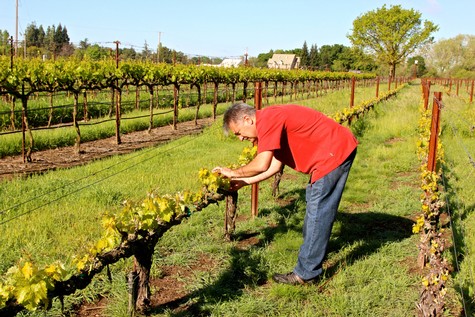
Bokisch Vineyards owner/grower Markus Bokisch attending to his Las Cerezas Vineyard Tempranillo in spring.
2014 Tizona by Bokisch Vineyards, Gran Reserva Lodi Tempranillo ($65)
The Bokisch family planted its first Tempranillo—a massal (i.e., mixed field) selection from Spain's Ribera del Duero region—in the late 1990s. Their Gran Reserva program represents the family's supreme effort with the grape, a 100% varietal bottling culled from their Las Cerezas (Mokelumne River AVA) and Liberty Oaks (Jahant AVA) vineyards.
While it took a while to gain a true sense of sensory cohesion, the 2014 Bokisch Gran Reserva has recently come together after aging over five years in bottle and oak puncheons (36 months in latter). Aromas of cocoa, anise, dark cherry and forest floor mingle with a dark cherry-like fruit perfume; and on the palate, a sturdy yet supple, fleshy medium-full body is filled out further by the oak (contributing cedar and spice along with a touch of supple leather) without being overwhelmed by that component. Altogether, a revelation with grilled red game or earthy dishes such as truffled scented mushroom risotto. If anything, a true connoisseur's Tempranillo.

